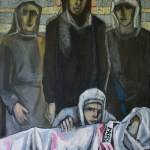
Abed Abdi’s art is chiefly rooted in the autonomous sphere constituted by the language of Arabic literature and the Arabic press. In 1964 he left for art studies in Dresden, where he created many drawings which were published in the Arabic press, portraying refugees in a geographically unidentified space. In Untitled (1968), a caravan of refugees wriggles like a snake under the blazing sun, like those long caravans of deportees heading toward an unknown future. Another drawing from the same year portrays a Palestinian woman and her child under a sabra hedge, attesting that the refugeeism described by Abdi is not based exclusively on the experience of the refugee camps in the Arab world, but also alludes to internal refugees living within the 1948 borders.
Between 1972 and 1982, upon his return to Israel after graduation, Abdi worked as the graphic designer of the Communist Party Arabic-language newspaper, al-Ittihad, and the literary review Al-Jadid, leaving his imprint on the visual culture of the Palestinian minority in Israel. From 1980 to 1982 a collection of short stories by Salman Natour entitled Wa ma nasina (We Have Not Forgotten), addressing the events of the 1948 Nakba, was published in the literary periodical Al-Jadid. The narrator was a furrow-browed old Sheikh. Each story commenced with a drawing by Abdi, and its title was incorporated into the drawing. Thus, for example, the opening drawing for the story “From the Well to the Mosque of Ramla,”2 features the old man, a sorrowful expression on his wrinkled face, extending his hands in a cross composition; next to him are wailing women, and at their foot-a dead body dressed in a shroud. Under the drawing, the “wrinkly-faced sheikh” describes what happened in Ramla’s Wednesday market in March 1948, the explosion of the bomb that was placed between the vegetable stalls and caused many deaths. The tension between the text dealing with violence and loss, the horizontal composition of the drawing, the dark and heavy figures, and the location of the drawing in an abstract geographical space marked solely by a contour of a minaret charges the drawing with a timeless symbolical system. The prone body, its face concealed, is a victim at once specific and universal.
In other drawings the dialectic between detailed text and symbolical drawing recurs. One such example is Trap in Khobbeizeh depicting a group of women observing the worst of all. A group of women also accompanies the story “Like the Sabra in ‘Eilabun,” where a wounded figure is lying on the ground, and a woman hesitatingly touching the face. Several female figures are presented in the back, covering their faces in grief. They are located in an empty space, far away from any place of settlement or help. The figure lying on the ground is mentioned in the story, and is identified with the main figure in the story of the ‘Eilabun massacre, the Maronite Church custodian, Sama’an al-Shufani, whose body was left near the church.3
The tension between the detailed text and the symbolical drawing is also discernible in a preliminary sketch for the poster of the play Men in the Sun. Abdi created the décor for the play when it was staged in Arabic at Al-Midan Theater in Nazareth in 1979 (director: Riad Masarwi). This preliminary study contains a square divided into two different parts: on one side stand three figures wearing keffiyehs, their bodies sketched in contours only; the crowded figures raise their hands upward, as if they were about to fall to the other side of the drawing. Lying on the ground on the other side are three figures that look dead; the face of one is turned upward, whereas the other two face the ground. While the standing figures cry and their keffiyehs identify them as Arabs, the lying figures do not wear keffiyehs, and thus represent universal suffering in an entirely abstract space.
In the refugee drawings, in drawings from the series “Wa ma nasina,” and in those which accompanied the play Men in the Sun, the figures are located in an abstract geometrical space, which is sometimes sketched graphically with only a few lines. The figures are positioned on the white paper, drawing their local, concrete power from the textual, literary space. This textual space includes rich literary writing by authors and poets, among them Emile Habibi, Anton Shammas, Mohamed Ali Taha, Salman Natour, Samih el Kassem, and others, who lend the drawings the concrete political contexts of their time.
Born in Haifa, 1942. Lives and works in Haifa.



















